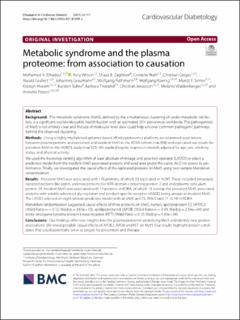| dc.description.abstract | Background
The metabolic syndrome (MetS), defined by the simultaneous clustering of cardio-metabolic risk factors, is a significant worldwide public health burden with an estimated 25% prevalence worldwide. The pathogenesis of MetS is not entirely clear and the use of molecular level data could help uncover common pathogenic pathways behind the observed clustering.
Methods
Using a highly multiplexed aptamer-based affinity proteomics platform, we examined associations between plasma proteins and prevalent and incident MetS in the KORA cohort (n = 998) and replicated our results for prevalent MetS in the HUNT3 study (n = 923). We applied logistic regression models adjusted for age, sex, smoking status, and physical activity.
We used the bootstrap ranking algorithm of least absolute shrinkage and selection operator (LASSO) to select a predictive model from the incident MetS associated proteins and used area under the curve (AUC) to assess its performance. Finally, we investigated the causal effect of the replicated proteins on MetS using two-sample Mendelian randomization.
Results
Prevalent MetS was associated with 116 proteins, of which 53 replicated in HUNT. These included previously reported proteins like leptin, and new proteins like NTR domain-containing protein 2 and endoplasmic reticulum protein 29. Incident MetS was associated with 14 proteins in KORA, of which 13 overlap the prevalent MetS associated proteins with soluble advanced glycosylation end product-specific receptor (sRAGE) being unique to incident MetS. The LASSO selected an eight-protein predictive model with an (AUC = 0.75; 95% CI = 0.71–0.79) in KORA.
Mendelian randomization suggested causal effects of three proteins on MetS, namely apolipoprotein E2 (APOE2) (Wald-Ratio = − 0.12, Wald-p = 3.63e−13), apolipoprotein B (APOB) (Wald-Ratio = − 0.09, Wald-p = 2.54e−04) and proto-oncogene tyrosine-protein kinase receptor (RET) (Wald-Ratio = 0.10, Wald-p = 5.40e−04).
Conclusions
Our findings offer new insights into the plasma proteome underlying MetS and identify new protein associations. We reveal possible casual effects of APOE2, APOB and RET on MetS. Our results highlight protein candidates that could potentially serve as targets for prevention and therapy. | en_US |

